
As I was coming up, it always seemed like I was learning. If it
As I was coming up, it always seemed like I was learning. If it wasn't from school, it was the 'hood. The influences of the 'hood are very powerful.






Hear the voice of a warrior-scholar who learned beneath two roofs: “As I was coming up, it always seemed like I was learning. If it wasn’t from school, it was the ’hood. The influences of the ’hood are very powerful.” In these few lines, Junior Seau offers a map drawn with chalk and nerve: two classrooms, two teachers—the textbook and the streetlight—each demanding attention, each shaping the person who will step onto the field of life. He speaks as one who felt knowledge arrive in waves: first bell and last bell, whistle and siren, sermon and swagger. What he calls learning is not the narrow corridor of grades; it is the wide road of survival, loyalty, timing, and heart.
The ancients would have understood this double academy. One school teaches letters; the other teaches looks. One measures answers; the other measures consequences. In school, you learn the names of things; in the ’hood, you learn the weight of them. The first classroom says, “Explain”; the second says, “Decide.” Together they temper a soul like folded steel—mind keen, instincts awake, courage taught to rise quickly and bow when needed. To deny either teacher is to limp; to honor both is to walk with a stride that knows both library silence and sidewalk thunder.
Note the word powerful. The ’hood is a forge of heat and pressure: elders who bless and warn, peers who dare and dare again, corners that test whether your word is a bridge or a trap. Here you learn to read a room the way sailors read a sky—small signals, sudden squalls, when to tack and when to ride it out. If you are careless, the influences bruise; if you are wise, they build. Seau’s confession is not romance; it is reverence for a place that can make or unmake a life, and for the discipline required to harvest strength without surrendering your center.
Consider a story that rhymes with his truth. A young athlete straddled two worlds: classroom by day, pickup games by dusk, family duty threaded through both. A teacher saw the fire and taught him calculus as if it were choreography; a coach saw the edge and taught him restraint as if it were armor. In the ’hood, an older neighbor—once a star, now limping on choices—told the unvarnished tale: “Talent is a door; character is the house.” The boy listened. Years later, when cameras asked for the origin of his poise, he spoke of both schools—the equation that steadied his mind and the alley that steadied his nerves. He carried honors not as ornaments, but as proof that knowledge can be gathered from asphalt as surely as from oak desks.
Seau’s line also teaches triage: when one source of learning runs dry, another can flow. A bad week in class does not end your education if you can still learn from the street’s theater of loyalty and consequence; a rough season in the ’hood does not doom you if mentors in school can name your gifts and show you the road beyond the block. The secret is appetite—eyes that keep hunting for lessons until lessons begin to hunt for you. Thus a person becomes weatherproof: rain or shine, there is study.
The lesson for us, then, is to braid our educations. Let school give you frameworks, words, maps; let the ’hood give you timing, courage, and the grammar of respect. Translate between them. Bring data to the corner and bring the corner’s wisdom to your essays and your work. Refuse the false war between book-smart and streetwise. The whole craft is to be both—to be literate in ideas and fluent in people, to move from classroom to curb without changing the truth of your name.
Carry these practices like chalk lines you redraw each day: (1) Name your teachers—a coach, a cousin, a custodian, a counselor—and ask each for one lesson this month. (2) Keep a dual journal—one page for what school taught you, one for what the ’hood taught you; read them together on Sundays. (3) Choose your circle—seek influences that sharpen without hardening; distance yourself from those that celebrate your worst day. (4) Serve both worlds—tutor at the rec center; invite a neighbor to your game or recital; let gratitude move in both directions. (5) Practice transfer—turn street instincts into leadership on teams and at work; turn classroom logic into wiser choices on the block. Do these with stubborn kindness, and you will discover what Seau lived: that the most powerful education is not either/or, but both—and that a life trained by book and by boulevard can stand steady when whistles blow and crowds roar, because its learning runs deep, and it never stops.






AAdministratorAdministrator
Welcome, honored guests. Please leave a comment, we will respond soon